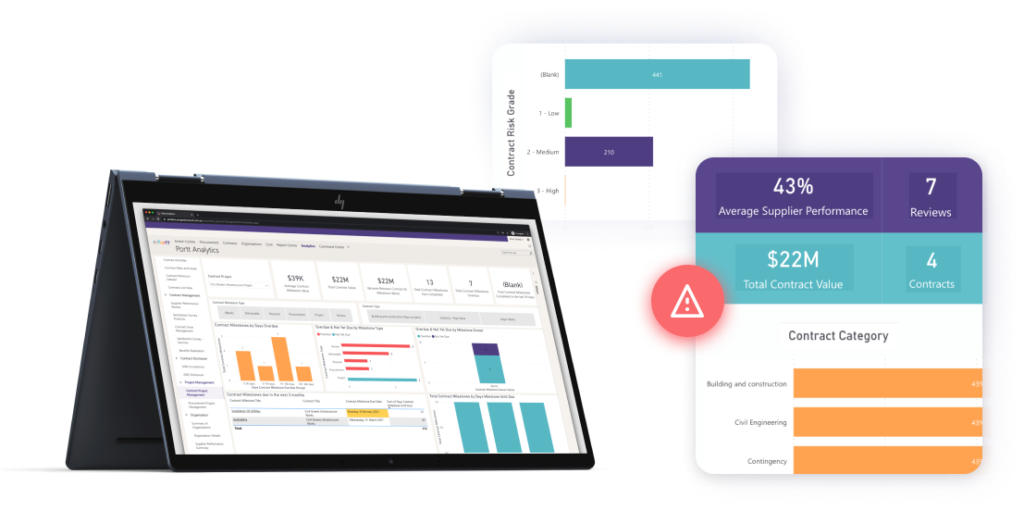A Comprehensive Guide to Contract Lifecycle Management

Portt is your intelligent sourcing, contract and supplier management platform. Here to enable the strategic potential of your procurement team. Streamline the necessary, unlock the opportunity, realise the outcomes.
Designed for the modern enterprise, the Portt platform takes your sourcing activities and supplier contracts and transforms them into strategic business assets. With Portt, you’ll have the building blocks to address the strategic needs of today to build for tomorrow.
Our regularly updated library of resources will help you better understand who we are and how we can assist to improve your business operations.
Thank you for connecting with us, one of the Portt team will respond to you shortly.

Contract lifecycle management (CLM) is the end-to-end process of overseeing supplier contracts to ensure a business gets what it has been promised under the terms that have been set.
In growing organisations that maintain contracts with hundreds, if not thousands, of individual suppliers, CLM is a vital means of ensuring operational efficiency and profitability. Yet all too often it’s carried out on an ad hoc basis that directly cuts into the bottom line.
Understanding CLM as a proactive process that extends from contract creation right through to renewal is key to slashing these risks. This guide will take you through each step of the process, as well as contract management best practices and challenges.
While contracts vary in length, they all go through the same stages when managed properly. In order these are:
The contract lifecycle management process begins with a stakeholder in the business requesting a contract for a particular good or service. This should specify:
The more information provided at the requests stage, the easier it is to draft a contract which satisfies all parties.
Once the business has agreed on the requirements of the contract, the document itself is drafted and approved by internal stakeholders. Depending on the type of contract, it might also require the input of legal counsel when it comes to terms and conditions.
The contract is then negotiated between parties, a process which can itself take a considerable amount of time depending on the size of the contract and the number of stakeholders involved.
Once the contract has been negotiated, it needs to be approved by all parties. Generally this involves a final review, which takes into account all edits and alterations made to the original contract. An electronically generated audit trail can make this process far more streamlined.
Following agreement, the contract is formally signed by delegates from both parties, either electronically or hard copy form. A copy is then kept on record by both the buyer and the supplier.
Throughout the contract, both parties are obliged to hold to their obligations (e.g. the delivery of specified goods and services for the supplier, or a set payment schedule for the buyer). This requires active management throughout the contract to ensure both parties receive what they signed for.
Contract compliance is the process of ensuring suppliers adhere to the various rules and guidelines outlined in the contract. For example, regular checks and balances might be needed to ensure workplace safety measures, invoicing protocols, and insurance requirements are correctly followed.
As the contract nears its closing date, both parties should revisit it and determine whether any terms need to be renegotiated before renewal. On the buyer’s side, this should be informed by a holistic view of the total ROI and benefits captured across the contract lifecycle. Armed with this data, contract managers can make an informed decision about whether a contract should be terminated, adjusted, or renewed as is.

Without a single, accessible location where you can view all your contract activity at a glance, it’s almost impossible to effectively manage contracts and supplier activity. Unsurprisingly, a report from Aberdeen Group Research found that “best-in-class organisations are 43% more likely to hold contracts in a central repository”.
In the age of digital transformation, a contract management system offers the most reliable and secure hub for all your contracts, however you can also create one using your internal systems (e.g. cloud based documents). Just ensure it’s secure, and versions are managed appropriately to avoid confusion.
Writing a contract from scratch can delay a procurement for months, especially when it needs to be legally ratified. It also increases the risk of a costly error, such as omitting a vital clause or condition.
A far more effective approach to contract authoring is to build a standardised collection of templates for different scenarios, which can then be filled in with the relevant details for individual contracts.
A contract management system such as Portt will generate these templates automatically, but they can also be created manually and stored in a centralised location. Have your legal team pre-approve each template too so contracts can be approved as soon as possible.
Regular compliance checking often falls by the wayside in day to day contract management, but it can save a business the huge costs incurred when suppliers don’t follow the rules.
As part of the contract itself, clearly specify how and when your supplier’s compliance will be audited, and stick to the schedule. A contract management system such as Portt will also automatically alert you to any upcoming compliance activity – so no scheduled checks slip through the cracks.
Supplier performance management is the ongoing assessment of a supplier’s performance for the duration of the contract. The more frequently this occurs, the easier it is to detect risks and performance gaps.
To facilitate good performance management, it’s important to agree on transparent key performance indicators (KPIs) with each supplier. These can then be measured with assessment tools such as scorecards and dashboard reports, if using a supplier management system.
KPIs (key performance indicators) give you clear metrics for measuring the success of a contract. This data in turn allows you to proactively manage suppliers and make strategic decisions about whether to renew or adjust a contract.
Specific KPIs will vary according to industry, but they generally fall into one of three categories:
such as number of milestones met, delivery times, and project completion rates
such as annualised contract value, remaining value after termination, and order value variance
such as the number of delays, defects, and clause deviations
Whichever KPIs you monitor, make them as transparent as possible with your suppliers by specifying them in the contract.
Without the ability to benchmark performance against past contracts, it’s difficult for businesses to get a true sense of contract ROI. For this reason, best-in-class organisations keep all their historic contract performance data on file as a point of reference for future procurements.
A contract management solution can give you even more strategic ability by allowing you to benchmark against industry averages. For example, Portt allows businesses to share contract data with each other so you can see the performance of other suppliers within your sector – as opposed to just your own.
Contract management has no shortage of challenges, particularly in growing organisations where internal systems struggle to keep pace with sourcing. Many contract managers find themselves struggling with:
It’s impossible to get a clear overview of all contract activity when contracts themselves are stored across a patchwork of shared drives and antiquated filing systems. Some organisations complicate the process even further by having outdated versions of the same document saved in multiple locations.
A centralised contract management platform is the single best way to eliminate these difficulties. With all documents automatically centralised, updated, and easily accessible to every stakeholder, your team can finally see where they stand.
A robust contract management system should contain a fully auditable record of all contract activity, from compliance scorecards to approvals. However, this is rarely the reality in businesses that manage contracts across isolated email chains and word of mouth agreements. With vital updates not recorded in any shared system, miscommunication becomes endemic.
Without an automated system for tracking contract spend, leakage tends to go unnoticed before it’s too late. As a result, businesses often lose thousands – sometimes millions – of dollars each year to simple invoicing errors and non-compliant work.
In the absence of a robust system, most contract managers find themselves bogged down in reactive administrative work: chasing delays, searching for missing information, and sending endless reminder emails to keep the workflow moving.
This leaves almost no time for strategic sourcing or contract management. New suppliers aren’t researched, compliance assessments go forgotten, and contracts renew automatically before they’ve been renegotiated.

CLM software is a digital solution for managing your organisation’s contract activity. With the right software you can:
CLM software ranges from simple plug and play solutions to complex platforms that require specialist IT support and infrastructure. When choosing a solution, it’s important to take into account:
Take the time to select the solution best suited to your organisation’s needs, and you can radically transform your entire contract management function for the better.
Save time and money with the fastest growing contract management solution in Australia and NZ.
